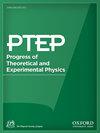金兹堡-朗道展开的收敛性:BCS 理论中的超导性和 NJL 模型中的手性对称破缺
IF 8.3
4区 物理与天体物理
Q1 Physics and Astronomy
引用次数: 0
摘要
我们研究了在有限温度 T 和化学势 μ 下,超导的 Bardeen-Cooper-Schrieffer (BCS) 理论和手性对称破缺的 Nambu-Jona-Lasinio (NJL) 模型中金兹堡-朗道(GL)展开的收敛性。我们介绍了这两个系统中平均场近似下 GL 展开系数的全阶公式推导。我们表明,BCS间隙Δ和动态夸克质量M的收敛半径分别由Δconv = πT和$M_{\rm conv} = \sqrt\{mu ^2 + (\pi T)^2}$ 给出。我们还讨论了这些结果的意义以及一阶手性相变附近 GL 扩展的定量可靠性。本文章由计算机程序翻译,如有差异,请以英文原文为准。
Convergence of Ginzburg-Landau expansions: superconductivity in the BCS theory and chiral symmetry breaking in the NJL model
We study the convergence of the Ginzburg-Landau (GL) expansion in the context of the Bardeen-Cooper-Schrieffer (BCS) theory for superconductivity and the Nambu–Jona-Lasinio (NJL) model for chiral symmetry breaking at finite temperature T and chemical potential μ. We present derivations of the all-order formulas for the coefficients of the GL expansions in both systems under the mean-field approximation. We show that the convergence radii for the BCS gap Δ and dynamical quark mass M are given by Δconv = πT and $M_{\rm conv} = \sqrt{\mu ^2 + (\pi T)^2}$, respectively. We also discuss the implications of these results and the quantitative reliability of the GL expansion near the first-order chiral phase transition.
求助全文
通过发布文献求助,成功后即可免费获取论文全文。
去求助
来源期刊

Progress of Theoretical and Experimental Physics
PHYSICS, MULTIDISCIPLINARY-PHYSICS, PARTICLES & FIELDS
CiteScore
12.00
自引率
5.70%
发文量
148
审稿时长
17 weeks
期刊介绍:
Progress of Theoretical and Experimental Physics (PTEP) is an international journal that publishes articles on theoretical and experimental physics. PTEP is a fully open access, online-only journal published by the Physical Society of Japan.
PTEP is the successor to Progress of Theoretical Physics (PTP), which terminated in December 2012 and merged into PTEP in January 2013.
PTP was founded in 1946 by Hideki Yukawa, the first Japanese Nobel Laureate. PTEP, the successor journal to PTP, has a broader scope than that of PTP covering both theoretical and experimental physics.
PTEP mainly covers areas including particles and fields, nuclear physics, astrophysics and cosmology, beam physics and instrumentation, and general and mathematical physics.
 求助内容:
求助内容: 应助结果提醒方式:
应助结果提醒方式:


